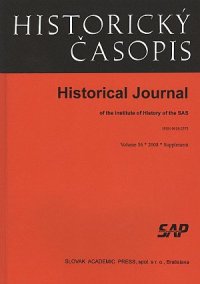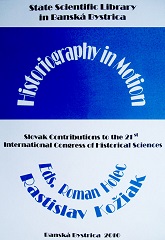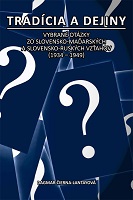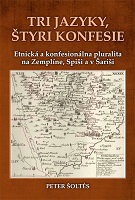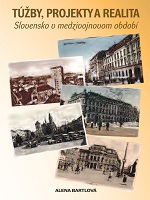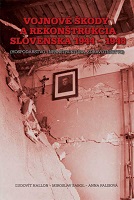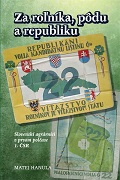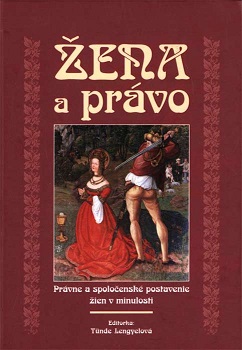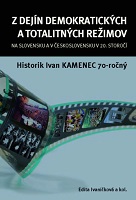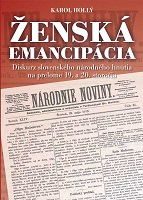Tri jazyky, štyri konfesie. Etnická a konfesionálna pluralita na Zemplíne, Spiši a v Šariši
Author(s): Peter Šoltés / Language(s): Slovak
Keywords: Slovakia; regions; languages; confessions: ethnicity; pluralism; Zemplín; Spiš; Šariš; Greek-Catholic communities; church; marriages; tradition;
Seit dem Mittelalter war das nordöstliche Teil des Königreichs Ungarn ein Grenzgebiet von drei ethnisch-sprachlichen Gemeinschaften, der ruthenischen/russinischen, slowakischen und ungarischen. Außerdem hat sich in diesem Raum die westliche, lateinische kirchliche Tradition mit der östlichen, byzantinisch-slawischen getroffen. Im Unterschied zum westlichen Europa haben sich in diesem Milieu im Rahmen des Prozesses der Konfessionalisierung nicht drei, sondern fünf Konfessionskirchen etabliert. Die inneren Migrationen auch innerhalb eines Komitats bewirkten hier die Veränderungen an der ethnischen und konfessionellen Karte. Nach den ständischen Aufstände und Verdrängung des Osmanischen Reiches aus Ungarn blieben weitläufige Teile der nordöstlichen Komitate entvölkert. Die Migration der Ruthenen/Russinen vom gebirgigen, wenig fruchtbaren Norden nach Süden, die sich am Ende des 17. und in erster Hälfte des 18. Jahrhundert in Bewegung setzte, hat einen enormen Ausmaß erreicht, sodass für seine Bezeichnung man in der Literatur eine Metapher über die „Ausuferung des ruthenischen Flusses“ finden kann. Die Massenmigration der sozialen Gruppe, die in Quellen unter den Namen Rutheni (lateinisch), Oroszok (ungarisch), Rusnáci (slowaksich), Ruthenen (deutsch) auftauchen, hat zur Erweiterung der griechisch-katholischen Kirchenorganisation in das Milieu der katholischprotestantischen Konfrontation geführt. Gleichzeitig haben sich im Rahmen der Migration die Ruthenen in die ethnisch slowakische und ungarische Umwelt ausgeweitet. Vor dieser Massenwelle war das nordöstliche Ungarn horizontal in drei relativ kompakten ethnisch-konfessionellen Gebieten geteilt. Am deutlichsten sieht man es am Beispiel des Zempliner Komitats, das sich von der polnischen Grenze bis zum Tokayer Gebirge erstreckt. In seinem nördlichen Drittel hat das ruthenische und konfessionell griechisch-katholische Element überwogen, im mittleren Teil dominierten die Slowaken, die konfessionell zwischen Römisch-katholische, Lutheraner und Kalvinisten geteilt waren. Auf den breiten Streifen der gemischten, slowakisch-ungarischen Dorfer knüpfte das ethnisch ungarische Milieu mit der Vorherschaft der reformierten Konfession an. Die empirische Forschung ist auf den Gebiet der Komitaten Zemplen, Scharos und Zips im nordöstlichen Ungarn fokussiert. Im 18. und 19. Jahrhundert gab es hier eine der höchsten Konzentration an lokalen Gemeinschaften mit vier Kirchengemeinden und mit drei ethnischen Gruppen. Im Laufe des 17. und 18. Jahrhunderts formte sich hier, an Peripherie, ein Zwischenraum mit einer außergewöhnlichen Intensität der interethnischen und interkonfessionellen Kommunikation. Sie führte zur Formgebung des sozialen Milieus mit ausgeprägter Pluralität nicht nur im Rahmen einer größeren geographischen Einheit, sondern auch in kleinen Lokalgemeinschaften. Sie prägte die soziale Realität in einem breiten Streifen der Dörfer mit vier Kirchengemeinden und drei Ethnien. Jede Kirchengemeinde hatte eigene liturgische Sprache und auch andere Schrift – die Lutheraner das Tschechische, die Griechisch-katholischen das Kirchenslawische, die Römisch-katholischen das Lateinische, die Kalvinisten das Ungarische und in etwa 20 Dorfer auch den Zempliner Dialekt. Die Unterschiede bestanden auch im Kalender und Kirchenfeiertage, in Formen der Religiosität und Volksfrömmigkeit. Der soziale Status der Priester, die Form der Rekrutierung und Qualität der theologischen und katechetischen Bildung war bei den griechisch-katholischen Popen lange Zeit niedriger, als in den übrigen Konfessionskirchen. Die kulturanthropologischen Forschungen über die gegenseitigen Kontakte und Beziehungen von verschiedenen sozialen Gruppen haben eindeutig gezeigt, dass die ethnischen, religiösen, sozialen und anderen Arten von Gruppen in den Vorstellungen der Menschen hierarchisch abgestuft sind. Jeder Gruppe ist in der hierarchischen Struktur eine bestimmte Stelle vorbehalten, von welchem sie sich in erster Linie um sich selbst und um die höher stehenden Gruppen interessiert. Die Gruppen der Minoritätsoder Subordinationsstellung nimmt man als uninteressant und minderwertig. Diese Erscheinung ist in der Soziologie gut bekannt und man ordnet sie zu den universalen Figurationen. Eine soziale Gruppe, die über größere Macht verfügt, schafft über sich selbst ein positiveres Bild, als über die schwächere Gruppe(n). Bei ihren Mitgliedern befestigt sich die Überzeugung, dass sie nicht nur stärker ist, sie besitzt im ökonomischen, sowie symbolischen Sinne mehr Kapital und deswegen entwickelter und wertvoller ist. Norbert Elias nannte diese Figuration Etablierten– Außenseiter. Die Quelle der Macht, die diese Dominanz ermöglichen, können unterschiedlicher Art sein – rassische, religiöse, ethnische, sozialer Ursprung, usw. Es besteht aber noch eine spezifische Begünstigung, die lange Zeit außer Betracht blieb, und zwar die Altertümlichkeit des Wohnens an einem konkreten Gebiet. Wie sieht es aber aus mit der Plausibilität der Etablierten– Außenseiter Paradigma unter Bedingungen einer ausgeprägten, durch die Migration zugefügten Pluralität? In Situationen, wenn die lokale Gemeinschaft aus drei, oder mehr sozialen Gruppen bestand, war die Dominanz des Stärkeren nicht so eindeutig und ausgeprägt. Die Kommunikation war schon in der ersten Generation nach der Ansiedlung intensiv sogar in solchen Bereichen, die üblicherweise mittels der Distanzierung und Stigmatisierung ausgeschlossen sein sollten: Mischehen, Konversionen oder in einer „fremden“ Kirchengemeinschaft praktizierte Frömmigkeit. Bei der Suche nach den Ursachen der leichteren Durchlässigkeit von interethnischen und interkonfessionellen Grenzen muss ein Faktor besonders hervorgehoben werden, der vom Anfang die sozialen Bindungen zwischen den Altangesessenen und Zugewanderten geprägt hat und zwar die große Entvölkerung. Im Zempliner Komitat war im Jahre 1715 nur jede dritte Bauernschaft bewohnt, etliche Dörfer fanden die Konskriptoren vollkommen entvölkert. Die Depopulation hat in diesem Zwischenraum die Desintegration der Familien- und Nachbarnbindungen, sowie der anderen sozialen Netzwerke in der Gemeinde verursacht. Der Vorteil, über den normalerweise die sozial geschlossene, miteinander gebundene Gruppe der alten Bewohner gegenüber der meistens heterogenen Masse der Zugewanderten verfügt, wurde erheblich entkräftet. Bei Wiederherstellung der Siedlungsstruktur war eine konsequente, distanzierende Einstellung der „ursprünglichen“ von den „neuen“ nicht zu erhalten. Eine wichtige Voraussetzung für das Durchdringen der ruthenen in die neuen Gebiete hat die Ungwarer Union im Jahre 1646 geschafft. Sie hat die kirchenrechtlichen und theologischen Grenzen zwischen den Gläubigen des lateinischen und des byzantinisch-slawischen Ritus abgeschafft, die Voraussetzungen auch für die Relativierung und Milderung der kulturellen und mentalen Barrieren gelegt und ihren Konfliktpotential reduziert. Einige Unterschiede zwischen der östlichen und der westlichen kirchlichen Tradition haben jedoch zur Entstehung von verschiedenen Figurationen. Am deutlichsten sieht man die Tendenz zur Entgrenzung der konfessionellen Identität an der Zahl der konfessionell gemischten Ehen und an unterschiedlichen Modellen der Kindererziehung in konfessionell heterogenen Haushalten. Die gesetzliche und gleichzeitig auch kirchenrechtliche Norm, die diese Situation regulieren sollte war die Reverspflicht. Vor der Eheschließung musste der nichtkatholische Partner einen Revers unterschreiben, in dem er mit der katholischen Erziehung aller Kinder zugestimmt hat. Die Verletzungen unterlagen einer strengen Strafverfolgung. Der Staatsapparat war in manchen Gebieten, unter anderem im Zempliner und Scharoscher Komitat, nicht imstande, die Achtung dieser Norm konsequent durchzusetzen. Es zeugen darüber die regelmäßigen Berichte der Bischofe und der Komitatsverwaltung an die Statthalterei, in welchen die Zahlen der Verletzungen angegeben waren. Die Skale der Losungen war ziemlich breit, von der Akzeptanz einer Konfession für alle Kinder, was aber nicht immer die katholische war, unterschiedliche Erziehung der Töchter und Söhne, Befolgung des ältesten, oder mindestens eines Sohns in der Vatersglaube u.a. Manche Eltern haben die Frage noch spektakulärer gelöst. Sie haben ihre Kinder nur taufen lassen und alle anderen Sakramente (Kommunion, Firmung, Konfirmation u.s.w.) auf die Zeit verlegt, als ihre Kinder selbst die Entscheidung treffen könnten, zu welcher Konfessionskirche sie angehören wollen. Ausmaß der Einhaltung des Reverses und die konkrete Lösung der Frage der kirchlichen Zugehörigkeit der Kinder haben die folgenden Faktoren geprägt: Fähigkeit der protestantischen Altbewohner ihre „Dominanz“, im Betreff an ihr ökonomisches und symbolisches Potential gegenüber dem griechisch-katholischen Teil der Lokalgemeinschaft zu behaupten, die Aktivität und soziale Prestige der lokalen Geistlichen und die soziale Prestige der Ehepartner. Das Toleranzpatent hat diese Frage gesetzlich neu geregelt, in dem die männlichen Nachkommen eines protestantischen Vater in seiner Konfession fortsetzen könnten. Bei allen anderen Fällen war der Vorzug der staatlichen Religion behalten. Von den konfessionellen Gruppen haben bei den Mischehen die griechisch-katholischen Partner die stärkste Tendenz dem Druck der Umgebung in der Sache der konfessionellen Zugehörigkeit der Kinder zu unterlegen. Man sieht es auch an der Zahl der durch die Ehe motivierten Konversionen. Die schwächere Resistenz der Griechisch-katholischen hing mit ihrer niedrigeren sozialen Stellung, mit der asymmetrischen sozialen Struktur und Absenz der politischen und ökonomischen Elite. Besonders in einer Minderheitsstellung im Rahmen der Lokalgemeinschaft waren sie oft auch mit der Wahrnehmung der „neuen“, „nicht autochthonen“ Glaube konfrontiert. Zusammen mit dem verspäteten Verlauf der Disziplinierung des Klerus waren diese Tatsachen bei den kirchenrechtlichen Streiten, zwischen dem römischkatholischen und griechisch-katholischen Klerus instrumentalisiert. Im den nächsten Generationen hat sich die asymmetrische soziale Schichtung in den gemischten lokalen Gemeinschaften gelockert und unter den wohlhabenden Bauern waren auch die Griechisch-katholischen ausgeprägter vertreten. In gleicher Zeit, etwa seit den 80er Jahren des 18. Jahrhunderts hat sich auch die Qualität des griechisch-katholischen Klerus, ihre theologische Vorbereitung, ökonomische Sicherstellung dem lateinischen Klerus wenn nicht ausgeglichen, dann mindestens wesentlich annähert haben. Die Unterschiede zwischen dem julianischen und dem gregorianischen Kalender und in Kirchenfeiertagen stellten eine andere Herausforderung für die interkonfessionelle Kommunikation. Die lokalen Gemeinschaften haben nach einem solchen Model gestrebt, das die religiöse Identität keiner der betroffenen Kirchengemeinde verletzen oder verunsichern würde. Die schmutzigen und schweren Feld- und Hausarbeiten hat man in den Feiertagen, egal welcher Kirchengemeinde nicht gemacht, damit es nicht zu den Vorfällen kam, dass ein Teil des Dorfes in die Kirche geht, während der andere sich an ihren Feldern abmüht. Es entstanden verschiedene lokalen Normen, die bei der Lösung dieses Problems die demographische und soziale Schichtspaltung der Dorfgemeinde, die Einstellung der Pfarrer, der Landesherren, die Häufigkeit der Mischehen und andere Faktoren berücksichtigt haben. Oft standen die religiösen Bedürfnisse der Dorfgemeinde im Gegensatz mit den Interessen der Landesherren, für welche die doppelte Zahl der Feiertage die wirtschaftliche Effektivität negativ beeinflusst hat. Seit 1780er Jahren hat der Staat die Maßnahmen zur Regulierung dieses Problems unternommen. Die josephinischen Verordnungen, sowie die späteren Versuche von Kaiser Franz den Zweiten, die den gregorianischen Kalender auf dem ganzen Gebiet der Monarchie einführen wollten gehörten zu den Gesetzen, die nicht durchgesetzt werden könnten. Aber die Unterschiede im kirchlichen Kalender waren auch zur demonstrativen Präsentation der symbolischen Dominanz und der religiösen Überlegenheit instrumentalisiert. Es könnte um individuelle Aktivitäten der Einzelpersonen gehen, sowie um gemeinsame Demonstration der Obermacht von der Seite der ganzen Kirchengemeinde, an der Spitze mit dem Pfarrer oder dem Landesherr. Die leichte Durchlässigkeit der konfessionellen Grenzen äußerte sich auch in der Rezeption von Elementen der barocken Frömmigkeit wie Rosenkranzgebet, Litaneien oder Kreuzwegandacht verbreiteten sich auch unter den Gläubigen des östlichen Ritus. Neben der „Barockisierung“ der Ikonostasen fand man in griechisch-katholischen Kirchen oft Statuen oder Nebenaltäre vor. Der westlichen Tradition nach passte man zudem auch das liturgische Kleid, die Länge der Bärte und des Haares an. Dieser Prozess der Akkulturation intensivierte sich nach der Synode in Zamość (1720), an welcher die griechisch-katholischen Bistümer im Königreich Polen die Dekrete des Tridentinums angenommen und dem östlichen Ritus angepasst. Die Beschlusse der Synode in Zamość waren ein paar Jahre später auch für das griechischkatholische Bistum in Munkacs obligatorisch. Der griechische Ritus hat im 18. Jahrhundert den Übergang aus der konfessionell homogenen Welt in das Milieu der konfessionellen Pluralität geschafft. Die Etablierung der dritten, in manchen Ortschaften gar der vierten Konfessionskirche, der griechisch-katholischen Kirche, hat dabei die interkonfessionelle Kommunikation tiefgreifend beeinflusst. Während in den bikonfessionellen Lokalgesellschaften die sozialen Normen zur konfessionellen Homogenisierung geführt haben, auf dem breiten Gebiet des nordöstlichen Ungarns eine solche Entwicklung unausführbar war. Die intensive interethnische und interkonfessionelle Kommunikation, die infolge der massiven Depopulation und Migration fasst eine demographische Notwendigkeit war, führte nicht nur zur einer schnellen Entgrenzung der kulturellen Unterschiede, sondern auch, wie man es am Beispiel der slowakisch und ungarisch sprechenden ruthenen, also Griechisch-katholischen sehen kann, zu ihrer Hybridisierung. Infolge der sprachlichen Assimilation der ruthenischen Migranten hat sich der homogene ethnische Charakter der Ecclesia Ruthenica verändert. Die Korrelation der ethnischen und religiösen Identität blieb aber noch lange Zeit den griechisch-katholischen Gläubigen inhärent. Die Tendenz der stärkeren sozialen Gruppe, die Kontakte seinen Mittglieder mit den „anderen“ zu stigmatisieren war in dem vorgestellten „Zwischenraum“ von Anfang an wesentlich geschwächt. Im langfristigen Horizont führte es zur Formgebung einer Art der Mentalität, für die ein hohes Maß der Toleranz und Resistenz gegenüber der konfessionellen oder nationalen Mobilisierung charakteristisch war.
More...
